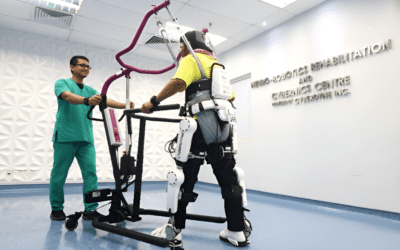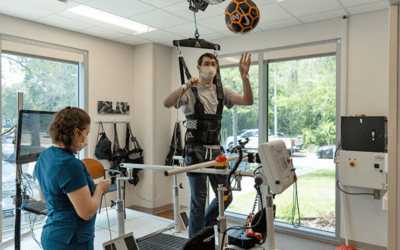Rehabilitation devices play a transformative role in the lives of individuals affected by Post-Traumatic Stress Disorder (PTSD) by providing innovative solutions for managing symptoms. Wearable technology, such as biofeedback devices, helps users monitor physiological responses and practice stress-reduction techniques. Virtual reality exposure therapy immerses individuals in controlled environments to confront trauma-related triggers safely.
Additionally, mobile apps for mindfulness and meditation support emotional regulation and coping strategies. These devices enhance therapeutic interventions and promote independence and confidence in daily activities. Ultimately, they contribute to improved mental health and overall well-being, fostering a path toward recovery.
Impact of Post-Traumatic Stress Disorder on Lives:

Post-Traumatic Stress Disorder (PTSD) significantly impacts various aspects of an individual’s life, often leading to profound emotional, physical, and social consequences. Here are some key areas affected:
1. Emotional Well-Being
- Individuals with PTSD may experience intense feelings of anxiety, fear, and depression. Flashbacks and nightmares can disrupt daily life, leading to heightened emotional distress.
2. Relationships
- PTSD can strain relationships with family, friends, and colleagues. Individuals may withdraw from social interactions or struggle communicating feelings, resulting in isolation and misunderstandings.
3. Physical Health
- Chronic stress associated with PTSD can lead to various physical health issues, including headaches, gastrointestinal problems, and cardiovascular diseases. Sleep disturbances may also affect overall health and energy levels.
4. Occupational Challenges
- The symptoms of PTSD can hinder job performance, leading to absenteeism, decreased productivity, and difficulty concentrating. Individuals may find it challenging to maintain employment or pursue career advancement.
5. Coping Mechanisms
- Many individuals with PTSD may turn to unhealthy coping mechanisms, such as substance abuse, to manage their symptoms. This can lead to further complications and deteriorate mental and physical health.
6. Quality of Life
- Overall, PTSD can significantly diminish an individual’s quality of life, affecting daily functioning and overall satisfaction. It can hinder one’s ability to enjoy activities that once brought joy, creating a sense of hopelessness.
The impact of PTSD extends far beyond the individual, affecting relationships, work, and overall well-being. Understanding these effects is crucial for providing appropriate support and effective treatment, enabling individuals to navigate their challenges and work toward recovery.
The Vital Role of Rehabilitation Devices in Recovery from PTSD:
Rehabilitation devices play a vital role in the recovery from Post-Traumatic Stress Disorder (PTSD) by offering innovative solutions that enhance therapeutic interventions and support coping strategies.
Here are some key contributions:
1. Biofeedback Devices
- These devices help individuals monitor physiological responses, such as heart rate and muscle tension, promoting awareness of stress levels. By using biofeedback, individuals can learn relaxation techniques and manage anxiety more effectively.
2. Virtual Reality Therapy
- Virtual reality (VR) provides immersive environments for exposure therapy, allowing individuals to confront trauma-related triggers in a controlled and safe setting. This approach can desensitize responses and facilitate emotional processing.
3. Mobile Applications
- Apps focused on mindfulness, meditation, and coping strategies provide accessible tools for daily practice. They empower individuals to engage in self-care routines and manage symptoms outside of formal therapy sessions.
4. Wearable Technology
- Devices that track physical activity and sleep patterns can help individuals understand their health and identify areas for improvement. Enhanced sleep and physical well-being contribute to better emotional regulation.
5. Cognitive Training Tools
- Rehabilitation devices that focus on cognitive skills can assist in improving attention, memory, and emotional resilience. These tools can be especially beneficial for individuals struggling with cognitive impairments related to PTSD.
6. Community and Support Networks
- Some devices facilitate connections with support groups and mental health professionals, fostering a sense of community and reducing feelings of isolation. Engaging with others who share similar experiences can be immensely healing.
Incorporating rehabilitation devices into the treatment plan for PTSD can significantly enhance recovery efforts. By providing tools for self-regulation, emotional processing, and community support, these devices empower individuals to take an active role in their healing journey, ultimately leading to improved mental health and quality of life.
Awareness of Post-Traumatic Stress Disorder (PTSD)

Raising awareness about Post-Traumatic Stress Disorder (PTSD) is crucial for fostering understanding, empathy, and support for those affected by this condition.
Here are the main objectives and strategies to achieve this goal:
1. Educate the Public
- Objective: Provide comprehensive information about PTSD, including its symptoms, causes, and effects on individuals and families.
- Strategy: Utilize workshops, seminars, and online resources to disseminate knowledge, making it accessible to diverse audiences.
2. Combat Stigmas
- Objective: Challenge the misconceptions and stigmas surrounding mental health issues, particularly PTSD.
- Strategy: Share personal stories and testimonials from individuals with PTSD to humanize the condition and promote empathy.
3. Promote Early Recognition and Intervention
- Objective: Encourage individuals to recognize signs of PTSD in themselves and others, facilitating early intervention and treatment.
- Strategy: Distribute informational materials through healthcare providers, schools, and community centers highlighting the importance of seeking help.
4. Support for Affected Individuals
- Objective: Create safe spaces and support networks for those living with PTSD and their families.
- Strategy: Establish support groups and online forums where individuals can share experiences and coping strategies, fostering a sense of community.
5. Advocate for Resources and Funding
- Objective: Push for increased funding and resources for research, treatment, and support services for PTSD.
- Strategy: Partner with mental health organizations to lobby for policy changes and allocate funds to mental health initiatives.
6. Utilize Media and Social Platforms
- Objective: Leverage media campaigns to reach a broader audience and raise awareness.
- Strategy: Use social media, podcasts, and blogs to share information, resources, and stories that promote understanding and support for those affected by PTSD.
Raising awareness of PTSD is essential to create a more informed and compassionate society. By educating the public, combating stigma, promoting early intervention, and advocating for resources, we can support individuals affected by PTSD in their healing journey and foster a culture of understanding and empathy.
Challenges of PTSD:
Post-Traumatic Stress Disorder (PTSD) presents several challenges that can significantly impact individuals’ lives. Those affected often grapple with intrusive memories, flashbacks, and nightmares, which can lead to severe anxiety and emotional distress. Social withdrawal is common, as individuals may struggle to connect with others, fearing judgment or misunderstanding.
The stigma surrounding mental health issues can exacerbate feelings of isolation and shame. Additionally, PTSD can affect daily functioning, hindering work performance and personal relationships. Overall, these challenges create a complex landscape that requires comprehensive support and understanding for effective management and recovery.
Therefore, Rehabilitation devices significantly transform the lives of individuals affected by PTSD by providing tools for coping, emotional regulation, and exposure therapy. By enhancing therapeutic interventions, these devices empower users to navigate their recovery journey and reclaim their quality of life.



